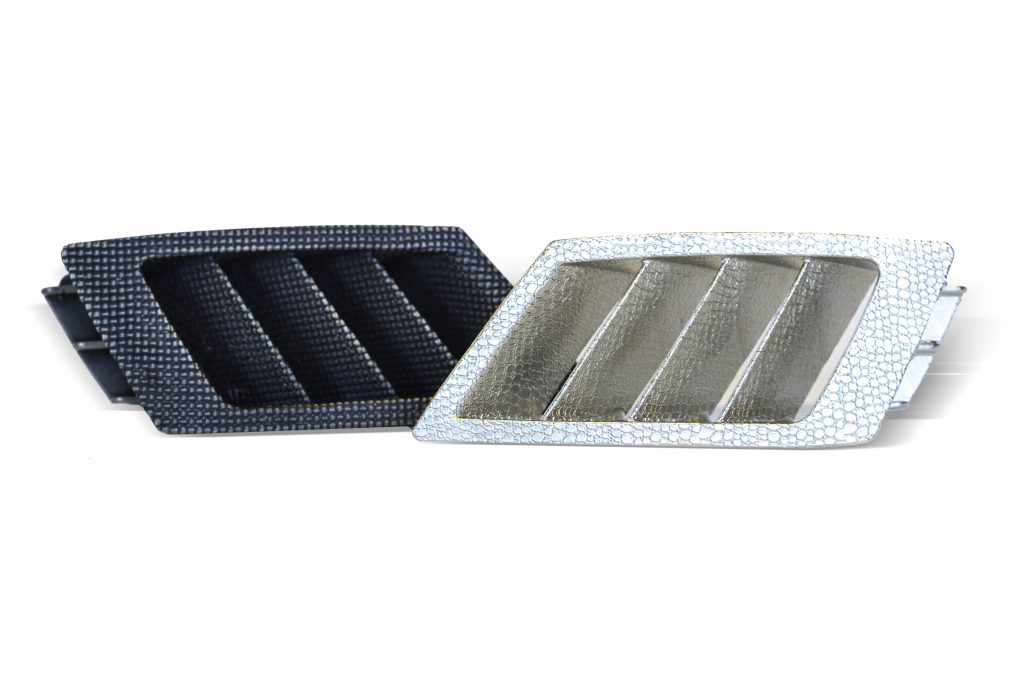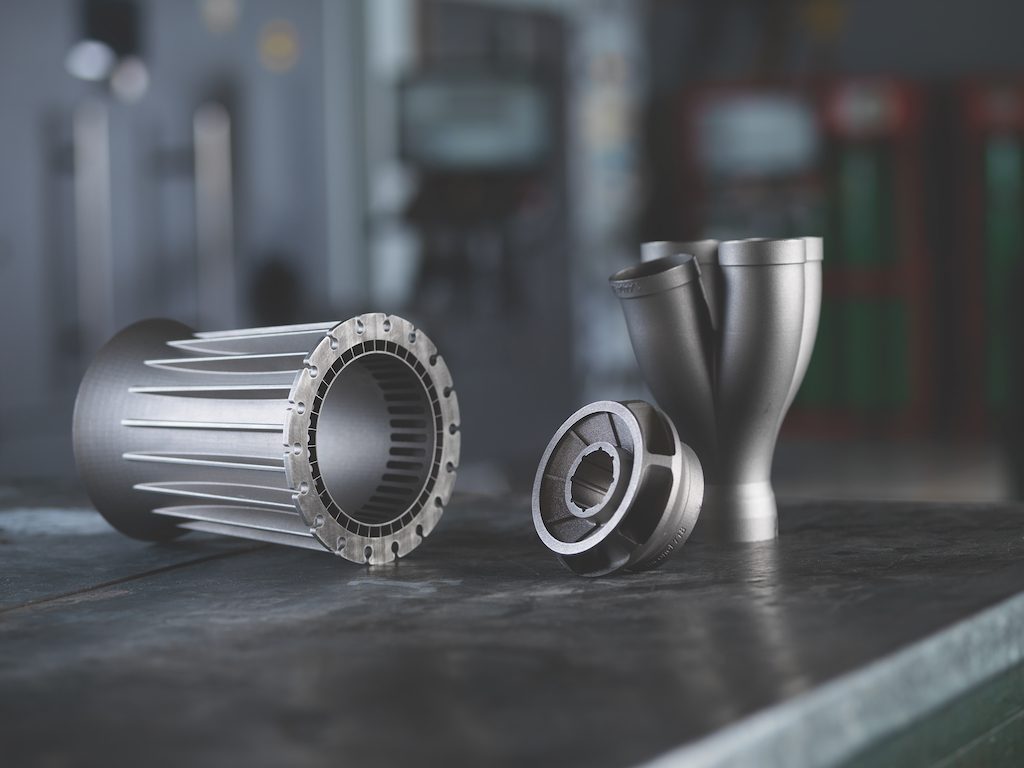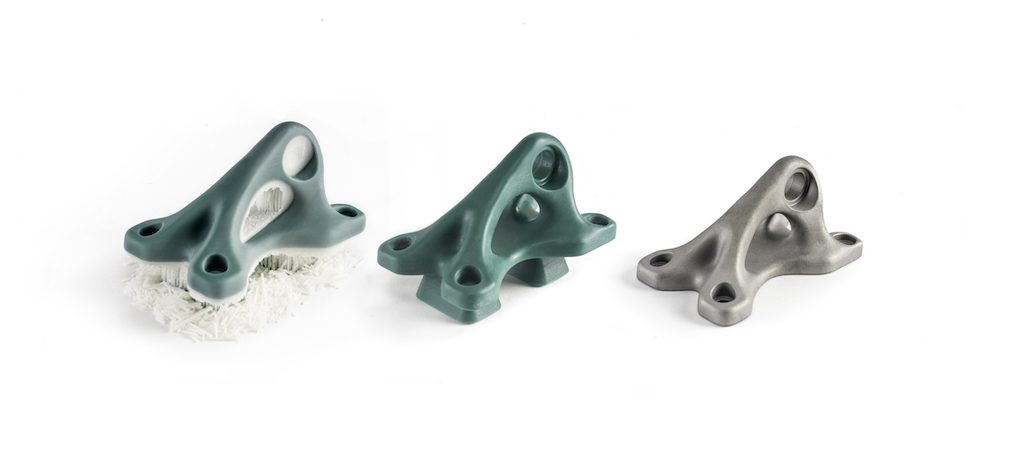Phil Schultz is the Executive Vice President, Operations, 3D Systems. Phil spent 25 years at HP rising to become GM and VP of their Imaging & Printing group. Then he initiated and created Foxconn’s printing business from the ground up turning it into a $2 billion revenue unit for the company. Now he’s heading up all Operations for 3D Systems after expanding their Quickparts and on-demand businesses previously. He is a key leader at 3D Systems that is part of the righting the 3D System ship and steering it into a profitable growth-oriented more efficient future. We interviewed him to learn more about on demand, the future of manufacturing and Phil’s thoughts on our industry.

A vent printed with 3D Systems’ Figure 4 technology, a plated version of the same vent is on the right.
Why should I use 3D Systems On Demand?
3D Systems’ On Demand offers the broadest portfolio of services in the industry – including both additive and subtractive manufacturing. We invented stereolithography (SLA) and we make extensive use of this technology plus many others including selective laser sintering (SLS), direct metal printing (DMP), colorjet printing (CJP), cast urethane/vacuum casting, CNC machining, sheet metal, die casting, low-volume injection mold tooling & parts, and investment casting patterns. In addition to the broad technology portfolio, 3D Systems has the broadest application and experience in the industry. This allows us to truly partner with our customers to help them meet their specific business needs. Our complete portfolio accelerates businesses and production for both novices and experienced professionals.
There are a number of new 3D printing services out there, how do you differentiate yourselves?
3D Systems is the only end-to-end solution provider in the industry, and also one of the only players with both metal and plastics technology. Additionally, our deep expertise allows us to partner with our customers to meet their business needs.
We have four offerings in our On Demand portfolio:
– Quick prototyping (i.e., QuickParts) – This is table stakes for anyone in the on demand services business
– Functional prototyping is our QuickParts service offering with post processing and secondary steps added. This tends to be more of a project-based service.
– Our low volume production service is available to produce hundreds to thousands of parts per month.
– We also create product concept/appearance models which include finishing to deliver a part that is representative of a final product to support marketing campaigns and customer testing.
Do you see yourselves developing more capabilities than just 3D printing?
We already do, and to be a true service bureau provider, you need to have more than additive manufacturing (AM). Keep in mind, AM is not the right solution for every challenge or situation.. And this is one area where the breadth and depth of our expertise comes to bear for our customers. It’s important to help customers understand where AM is appropriate versus other technologies. We do this because it’s essential to helping customers meet their business challenges.
What do you think the future of prototyping is?
Prototyping is critical for product development – specifically, accelerating learning for someone developing new offerings. The closer you can get to the end-product early in the product development lifecycle, the better off you are. Prototyping allows designers to run turn cycles faster and reduce investment in tooling.
Over the past couple years, additive manufacturing and prototyping have “taken the next step” if you will with materials that possess enhanced properties enabling a prototype that closely mirrors the end-product. These prototypes can seamlessly transition to production.
3D Systems’ Figure 4 platform can take a manufacturer from prototyping to full production on the same platform. This isn’t possible with other technologies in the industry.
What do you see happening in end-use manufacturing of 3D printed parts at the moment?
The key to getting to end-use manufacturing is in materials. We are seeing new materials in-market whose properties are inching ever closer to those of end use. There are essentially two types of materials: sintered and photo reactive polymers. The sintered materials are capable of producing durable end-use parts. For example, sintered materials are being used in aerospace, specifically for cabin parts. Adoption today is limited, but we believe this will proliferate, and will also become more commonplace in other industries. When you look at injection molding in a broad sense, this is a very large market. As a result, it won’t take a huge portion of the market to adopt to make a huge impact in the industry.
Is being a turnkey manufacturing solution your future?
3D Systems is already a turnkey manufacturer in the metal 3D printing world. We already do this in healthcare, for example. Some customers would prefer to engage with us on a piece/parts basis. Our customers and market evolution will take us where we need to go in this space. We already provide a turnkey manufacturing solution in low volume today with On Demand, but we haven’t formally called it a turnkey solution. What is most important to 3D Systems is doing what our customers need us to do to solve their business challenges in unique ways. That’s where we deliver value.

Stainless Steel 316L and Inconel 625 materials 3D printed on 3D Systems’ DMP ProX 320.
What should companies know before they try to get parts made with 3D printing?
It’s important to understand 3D printing is not a replacement for injection molding. If a customer has a high-value application for injection molding, they should stay with it. One of the most valuable reasons to move to additive manufacturing is, the technology deals with complexity better than traditional manufacturing. Additive is tremendous at producing complex parts. But this also requires mechanical engineers to transform how they think about designing parts. Everything they were taught over the last 30 years is backward from what makes design work for additive. There are different constraints, however, it dramatically opens the design space. The other thing to be aware of is choosing the right material with the right properties for the application. Matching material properties for every property of a thermoplastic is challenging. Fortunately, you don’t need to match all properties for all applications with additive to get to a durable, end-use part. With additive, manufacturers can reduce cost, simplify their supply chain, and also simplify assembly through part count reduction.
What advice would you give firms that wish to industrialize 3D printing for manufacturing?
I believe what was just addressed is all very important: understand the application, how to design for additive as well as select the most appropriate material for the application. Other points to consider include:
– Start with prototyping to fully understand how 3D printing fits into your supply chain.
– Know that with additive, there is no such thing as per part tooling.
– Understand that the part is not final when it’s done printing. It’s important for a manufacturer to understand all post processing requirements – including labor requirements – before taking the leap to additive. And also know that some post-processing systems are not as easy as others. One of the things that I am particularly proud of with Figure 4 is that it has a very easy post-processing system.
Will automation in depowdering/post processing be a key development for your business?
Absolutely. Post processing is a key development area for the entire 3D printing industry, particularly as we industrialize AM. Support removal, curing, washing – these are all important areas to develop. We’re seeing many smaller companies investing in this area today.
For 3D Systems, we are ultimately concerned about enabling our customers to create parts; therefore, we must think about the entire value chain. We talk about the power of additive manufacturing to lower total cost of operation (TCO). TCO includes the entire value chain which entails labor and post processing. And the more we can automate this process, the better it is for our customers.
Surface quality has always been a bugbear of 3D printing, what steps are you doing to improve it?
We designed the Figure 4 platform to deliver some of the best surface quality in the industry. Figure 4 allows the designer to build in surface texturing , and also has some of the best thermal control in industry. This is also on par with dimensional accuracy. The Figure 4 platform delivers part accuracy and repeatability, with Six Sigma repeatability (Cpk > 2) across all materials. The combination of speed and accuracy complemented by a light-based UV curing process that takes minutes versus hours with heat-based curing processes, yields the world’s fastest additive manufacturing throughput and time-to-part. Additional proof can also be seen with our ProX SLS 6100 as well as our MultiJet printing technologies. We have been able to achieve great surface finish with wax which has allowed us to penetrate the jewelry market. The ability to achieve the right surface finish allows you to unleash an industry.
3D printed part strength has also been a limitation. Are there any recent developments there?
To address this, I believe we need to focus on the materials and look at photo reactive versus sintered materials.
With sintered, we are not changing the chemistry of the materials as we cure and process. In this case, the strength of the materials is a function of materials themselves. If you look at 3D Systems’ ProX SLS 6100, we have made significant advances with the thermal control of system. With photo reactive polymers, the thermosets are behaving more like thermoplastics. We have a new chemistry in development that when it is released will allow us to create new property sets not seen before. This is part of the reason we’re so excited about the industrialization of additive manufacturing – with new materials and enhanced properties, what is achievable is absolutely game-changing.
What have been some key developments in SLS (powder bed fusion, Laser Powder Bed Fusion, Selective Laser Sintering)?
I believe the three key developments are thermal control, speed and temperature.
– The challenge with thermal control is a wide temperature variation across the print queue. Higher temperatures lead to more challenges with not only part creation but also part consistency. 3D Systems has spent quite a bit of time reducing temperature variation (from 10°C to 3°C).
– By moving to multi-laser systems with advanced power handling and slicing techniques, the speed of processing parts is improving dramatically.
– Temperature is the third key area of development. Most SLS printing is done with nylon and polypropylene. When you look at applications for aerospace and automotive, there is a need for higher temperature plastics. As a result, there is a need to build 3D printers that can handle these higher temperature materials.
How do you see the future of SLS?
There is a tremendous opportunity with this technology. SLS is a perfect technology to produce parts for the automotive and aerospace industries because of its ability to process true end- use materials not changed by reactions, but just the sintering process. There are significant opportunities for continued innovation in SLS because of the applications. Medical devices – such as orthopedics – is also a big opportunity for SLS. From 3D Systems’ perspective, this technology will be a key part of our portfolio for a very long time as it captures segments which are difficult to address with other technologies.
On the polymer side what do you see as nascent advances?
I believe the biggest change we are going to see is delivering thermoset materials that behave closer to thermoplastics. We’ll have tough materials that are not brittle, handle high temperature, and produce durable parts that have a long life. The key next step will be to move polymers beyond prototyping into more production-type applications.
Subscribe to Our Email Newsletter
Stay up-to-date on all the latest news from the 3D printing industry and receive information and offers from third party vendors.
You May Also Like
3D Printing Unpeeled: Orbex Investment, IndoMIM and HP, Ultrasonic Waves
INDO-MIM has bought three HP Metal Jet S100 printers, operating two in India and one in Texas. This is a win for HP because the company has deep experience in...
3D Printing News Briefs, April 3, 2024: Kickstarter FDM 3D Printer, Artificial Eyes, & More
In 3D Printing News Briefs today, we’re talking about an FDM 3D printer on Kickstarter, advancements in artificial eye creation, and 3D printed solenoids for electromagnets. Then we’ll move on...
Firestorm Gets $12.5M from Lockheed and Others to Automate Drone Production with 3D Printing
Firestorm Labs is advancing an initiative that has been a topic of discussion on our site for a while: automating drone swarm production. Drones are increasingly altering the landscape of...
3D Printing Leaders Team with Rivelin for Robotic Metals Post-processing
UK-based Rivelin Robotics is working on creating a manufacturing cell to automate the post-processing of metal 3D printed parts. If successful, this approach could reduce the costs of metal 3D...































